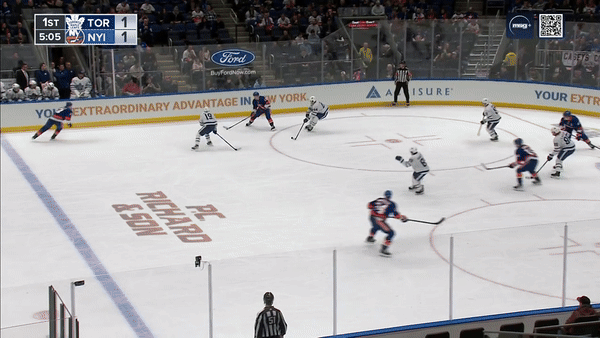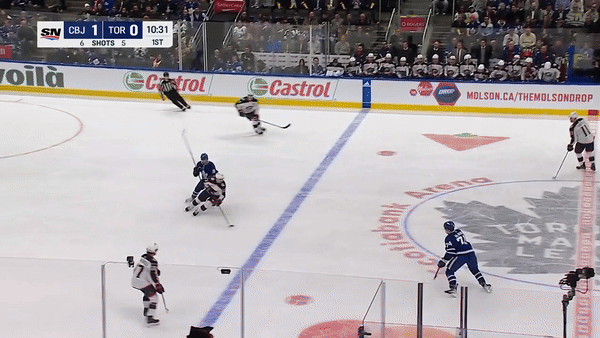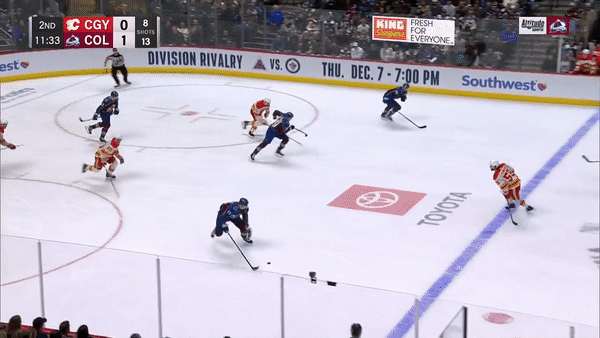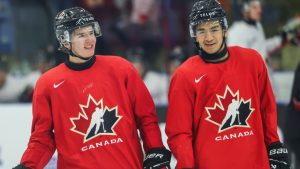Objectively speaking, it’s hard not to like Chris Tanev as a player.
He’s carved out a 14-year NHL career for himself after going undrafted, is as steady a defender as you’ll find, and plays with the kind of heart that sees him sacrifice his face for the sake of keeping the puck out of his net (both admirable and deeply concerning).
His details are textbook, he processes information at a high speed, and he doesn’t deviate from his game. It’s easy to envision him playing his game — and playing it well — in any environment.
That doesn’t, however, mean his game will be equally impactful in every environment.
Most of the trade chatter surrounding the pending unrestricted free agent has been linked to the Maple Leafs and many believe he’s exactly what Toronto’s blue line needs: grit, stability, consistency, and a guy hungry to win at all costs, face be damned.
But beyond what seems promising on the surface, how much value would Tanev really be able to add as a member of his hometown team?
We’ll explore this question by digging into his strengths and limitations (for someone who plays a pretty boring brand of hockey, he’s fascinating to study) relative to Toronto’s specific needs to see how the two align on a micro level.
GENERAL OBSERVATIONS
Given the old-school feel of his playing style, “cerebral” was not a descriptor I had on my Chris Tanev bingo card, but this adjective came to mind more than any other upon watching him closely. From his positioning to his timing, he plays a very intentional game that’s rooted in one core skill: awareness.
Tanev’s head is constantly on a swivel, allowing him to detect potential threats and opportunities early, swiftly make solid decisions, and operate proactively based on the information gathered. His awareness has translated to a knack for anticipating the play and being in the right spot at the right time.
Let’s start by examining the key areas in which he’s most effective without the puck thanks to these strengths.
WITHOUT THE PUCK
Protecting the slot
Tanev is adept at reading the play and impeding lanes at the right moment to prevent chances against, particularly from the most dangerous area of the ice. He’ll throw every body part imaginable at the puck, and uses his stick well to deflect shots and disrupt passes.
Here's a compilation of all three practices in action:
The alternate captain is tied for sixth in the league in shot blocks and has been on the ice for the fewest slot shots against per game among the Flames’ (and Leafs’) top four defencemen (by usage), per Sportlogiq.
The opposition also completes fewer passes to the slot per game when he’s out there compared to those other three Calgary defencemen. To put the significance of this stat into context, our subject has played 12 more shorthanded minutes while enjoying 51 fewer power play minutes than the next closest Flame in this group. His standing remains when sorted by per 60 minutes at 5-on-5 as well.
The Maple Leafs would benefit substantially from Tanev’s services in this department. Toronto has surrendered the fourth-most slot shots against per game this season and been bailed out on many occasions by goaltenders who’ve combined for the fourth-best slot save percentage.

He would help make life easier for Toronto’s goalies not only by minimizing good looks for the opposition, but maximizing good looks for the men in the crease. His ability to keep opponents out of his goalie’s grill by boxing them out or tying them up (and negating second-chance opportunities in the process) would be welcome on a team that allows the fifth-most screened shots and third-most screened goals per game.
While players with a penchant for blocking shots can be prone to screening their own goalie, Tanev is generally mindful of when to step into a lane (making sure he gets a piece upon doing so) and when to clear one.
Defending the rush
Tanev’s aptitude for controlling space in order to kill rushes or render them harmless is the facet of his game that impressed me most. He’s excellent at strategically applying pressure with angled routes and using his stick to maintain a tight gap, both of which allow him to influence the puck carrier’s speed and direction.
These tactics routinely produce favourable outcomes for Calgary as they:
• cause the puck carrier to delay, turn back, or take longer routes (i.e. stay to the outside), negating quick counters and preventing odd-man rushes from materializing
• buy time for teammates to track back, also preventing odd-man rushes
• trigger offsides
• force rushed passes or dump-ins
• steer opponents into coverage
Below are some examples of Tanev applying pressure at smart angles with his routes to proactively minimize danger. More on this detail shortly, but notice how aggressive he is without compromising his positioning (he basically just takes clever detours).
Here are further examples of Tanev’s tight gap, which also allows him to break up plays:
Justin Bourne wrote a great article last month about Toronto’s defence affording opponents too large a gap on entries, suggesting this area was the one the team most needed to address and – update – it doesn’t seem much has changed.

Sportlogiq lists Tanev’s gap distance today as almost a foot smaller than the closest defenceman who’s logged top-four minutes on the Maple Leafs. Beyond making opponents more uncomfortable on entries, his rush defence at large would significantly help a Toronto squad that gives up more chances and shots per game in this context than 27 other teams.
Positional discipline (AKA defence 101)
As previously alluded to, Tanev understands not only when to be aggressive (or back off) while defending, but perhaps more importantly how to do so while remaining well-positioned.
In contrast to many of the examples above, here’s a rush sequence where he stays in position and lets the play come to him.

If you’re thinking Tanev doesn’t do much here, you’re right – and that’s the secret to defending effectively in the NHL. Everything largely boils down to getting out of one’s own way, which seems simple in theory but is much more difficult in practice.
If you take any goal and break it down, chances are at least one player on the victimized team put himself in a bad spot. Maybe this player:
• chased the puck and pulled himself out of position
• watched the puck and lost his man
• overcommitted while pressuring the puck and couldn’t recover in time
• moved or turned his feet too soon and became vulnerable to manipulation
• or failed to read off a teammate and doubled up on coverage
Long story short, there are plenty of ways to cook oneself and when you do, you usually roast a teammate or two in the process as they attempt to compensate for your mistake. The premise here is if you get cooked, let it be a credit to the opposition's attack rather than your own doing.
Tanev rarely falls into the traps listed and is very positionally sound. He’s disciplined and trusts that if he does his job, his teammates will do theirs. He also identifies assignments and recognizes coverage switches or hand-off situations quickly and seamlessly, minimizing the lag time – another variable that can spell disaster – in his game.
All of these strengths are on display in the sequence below against an Avalanche team that’s arguably the best in the league at facilitating defensive mistakes via constant movement in the offensive zone.
The following video highlights another strong coverage read, this time off a faceoff where Tanev hustles to cover an opponent who he recognizes will be left unattended in the slot given his teammates’ responsibilities.
Though they aren’t sexy, these are the kind of details that keep pucks out of the net and that’s a priority for Toronto, who’s averaging the 10th-most goals against. If you re-watch the Leafs clips highlighted in the sections above, you’ll see unforced positional errors (particularly by defencemen) preceding several of the chances.
WITH THE PUCK
Tanev’s game with possession is equally straightforward. He’s a pass-first guy who makes the simple play and generally manages the puck well, boasting the highest puck touch success rate and lowest turnover rate among Calgary’s defencemen at 5-on-5.
He often shows poise under pressure and though he’s not the type to beat a forechecker himself or expose the opposition with some creative move, he can be deceptive. Watch how he holds on to the puck a second longer to open up passing lanes or pulls opponents in one direction before moving in another to shake pressure:
There are, however, times when this poise seems to escape him, particularly when handling the puck below his goal line. While he won’t just throw it away or pass it into traffic, he might send it to a teammate on the wall who isn’t necessarily in the best position to make the next play due to oncoming pressure or the way his body is oriented.
Tanev isn’t the most offensively gifted player, but he is keen to activate in the defensive zone when his team gains possession and to pinch in the offensive zone. He displays good instincts in both contexts, supporting teammates in transition and keeping sequences alive.
Toronto hasn’t received a ton of contributions offensively from its defencemen – 20.4 per cent of the team’s points have come from the back end this season, which ranks 31st – and Tanev wouldn’t be a major player in this respect. That said, his presence may give his partner (ideally someone more comfortable skating with the puck) the confidence and freedom to be more aggressive. Flames head coach Ryan Huska aptly referred to Tanev as a “security blanket” a few weeks ago.
In any case, the main ask of Tanev in Toronto would simply be to make plays that allow the Maple Leafs to successfully move the puck up-ice and he’s clearly capable.
PARTING THOUGHTS
At the ripe age of 34, Chris Tanev is still doing his thing. None of his physical tools are anything special, but his awareness and ability to think the game at a high level set him apart. He’s a prime example of the whole being greater than the sum of its parts.
Despite concerns surrounding his injury history, he’s only missed 20 games over the past five seasons and is consistently effective when in the lineup.
The key areas in which he excels are the same areas in which the Maple Leafs are struggling most. Akin to Tanev’s game, there’s a lot to like about the potential of this fit.
We’ll see if Brad Treliving can land his guy.
Vanessa Kezwer worked as a scout for the USHL’s Chicago Steel for three seasons and was a video analyst for TMU’s women’s hockey team.




 1:55
1:55
